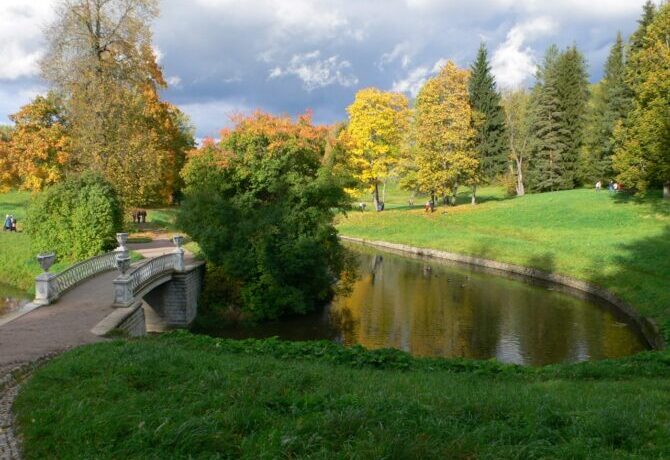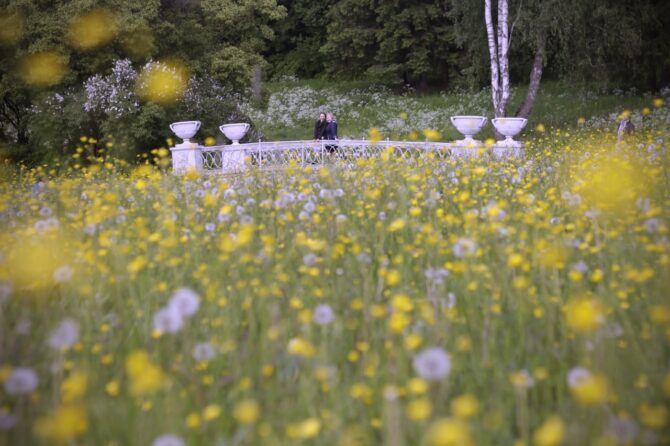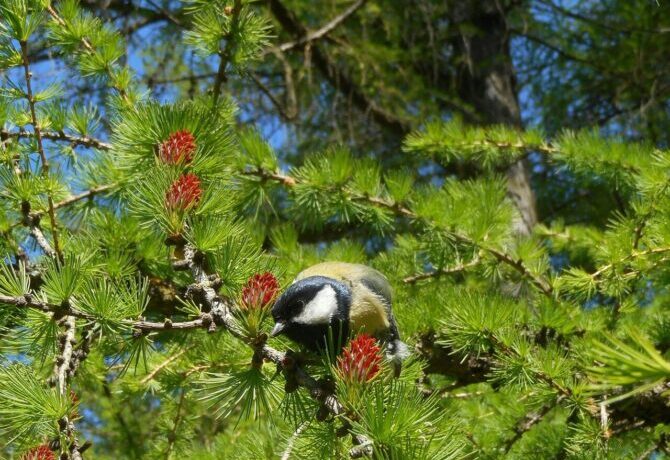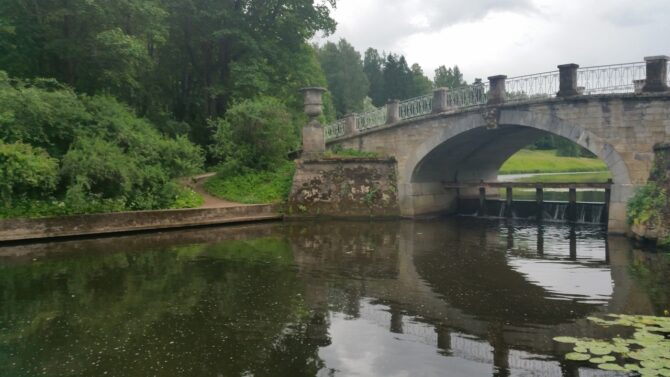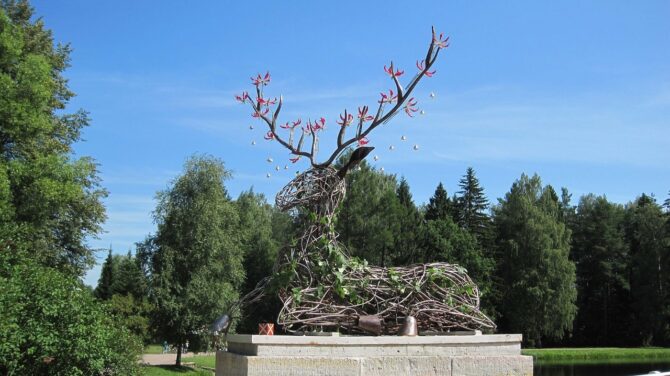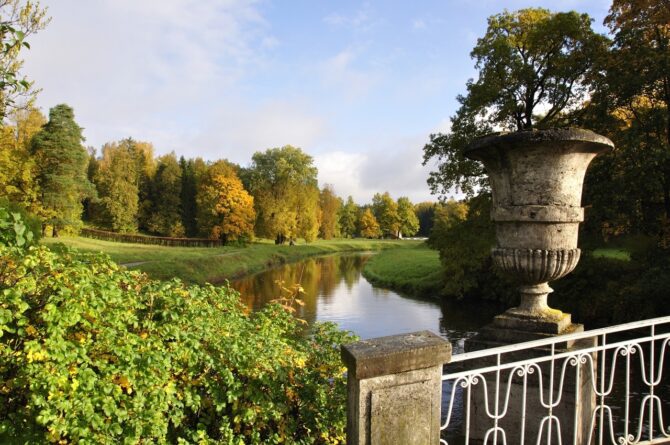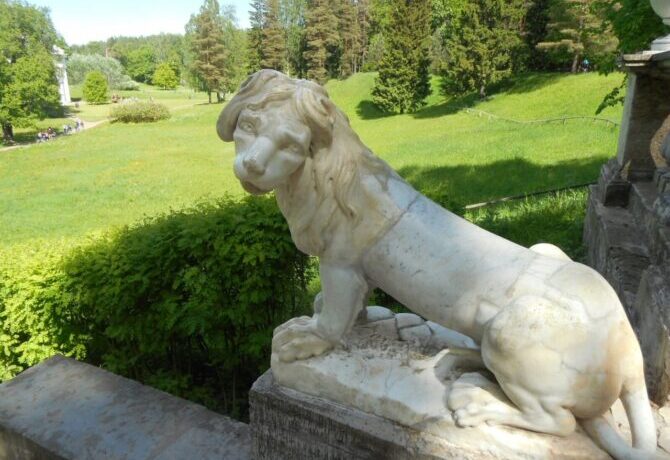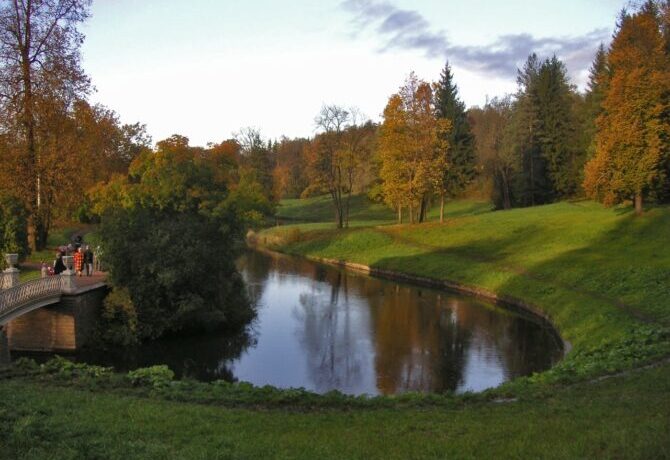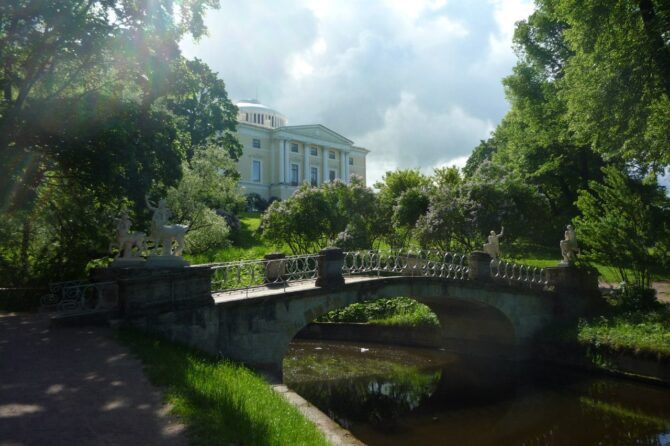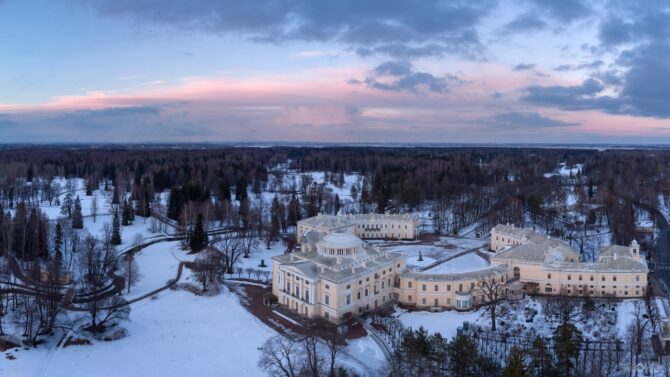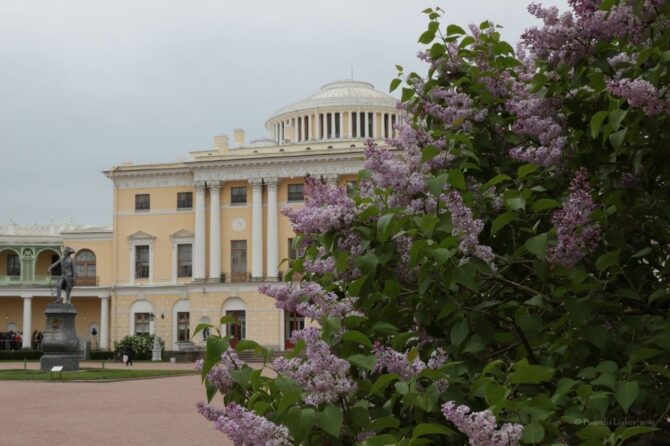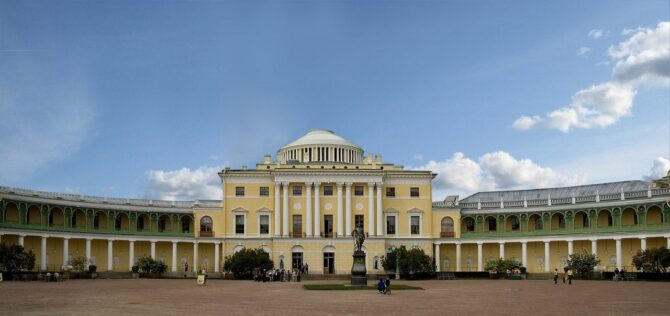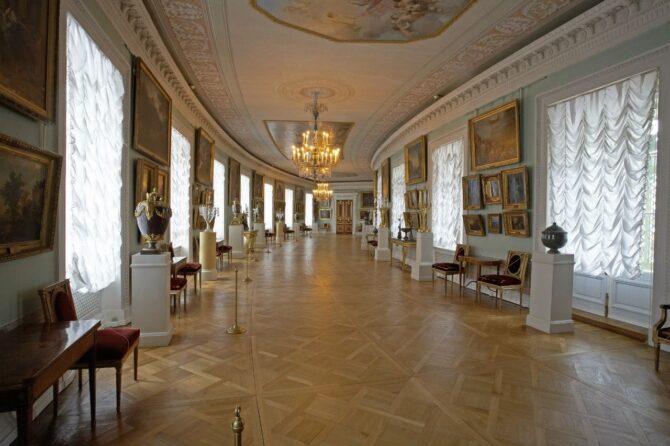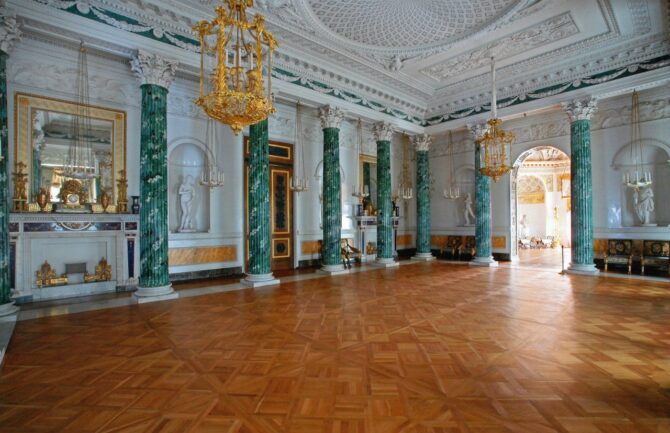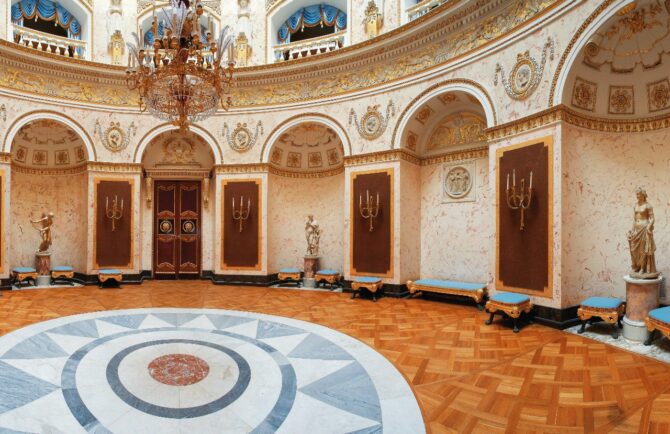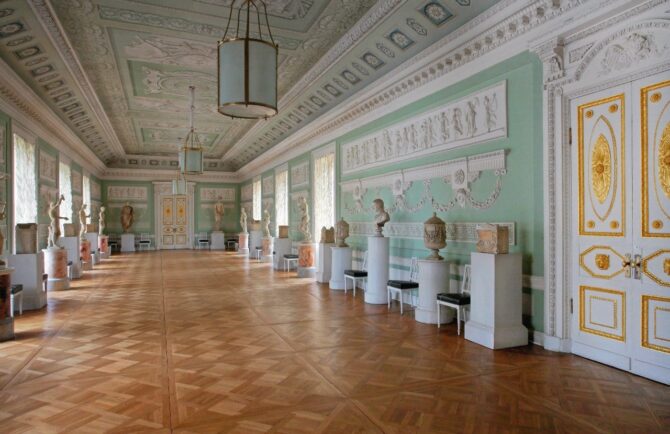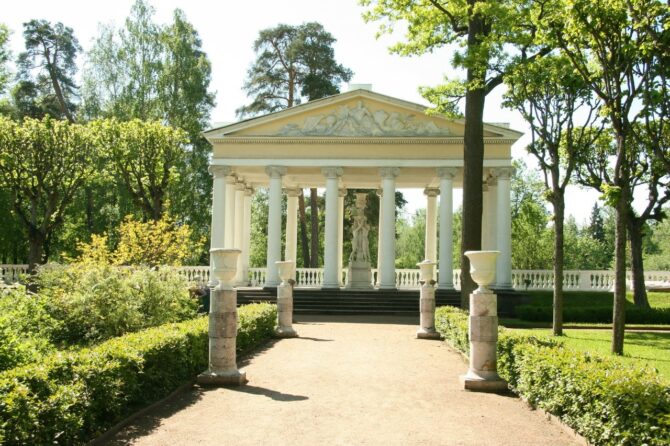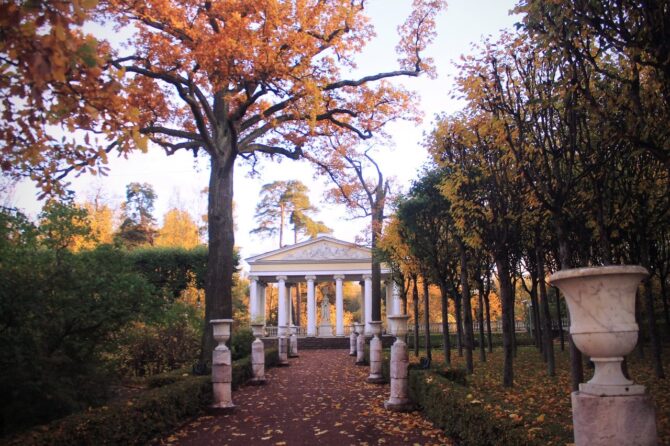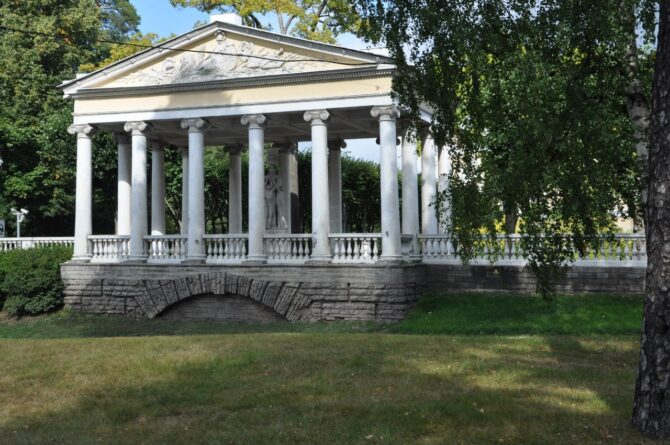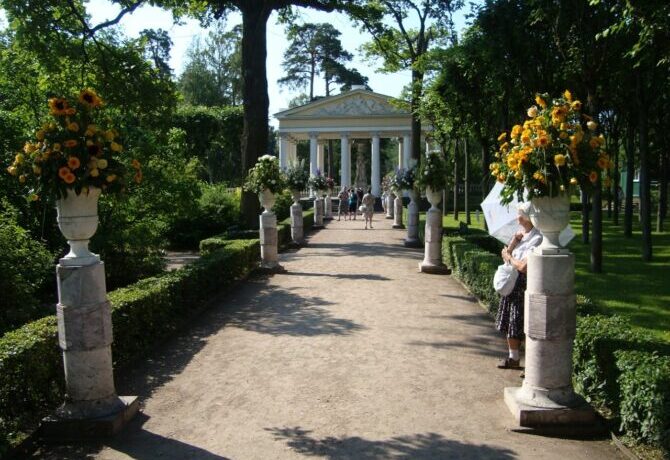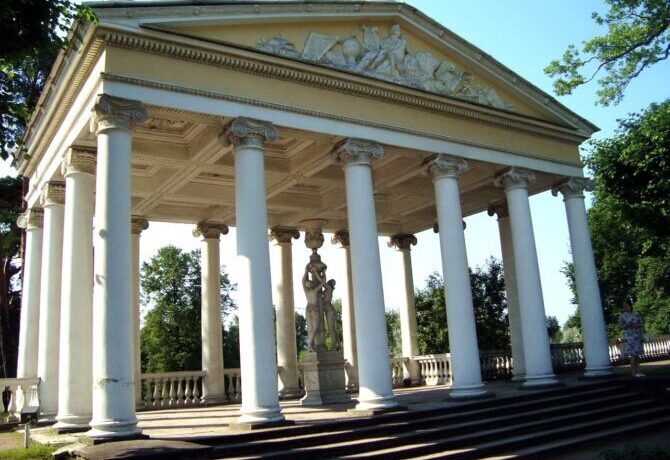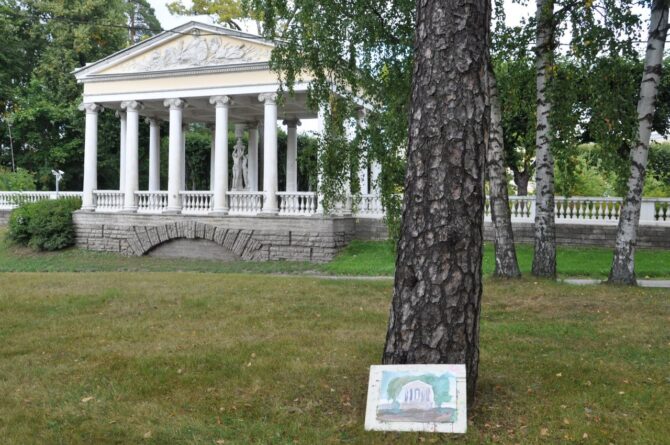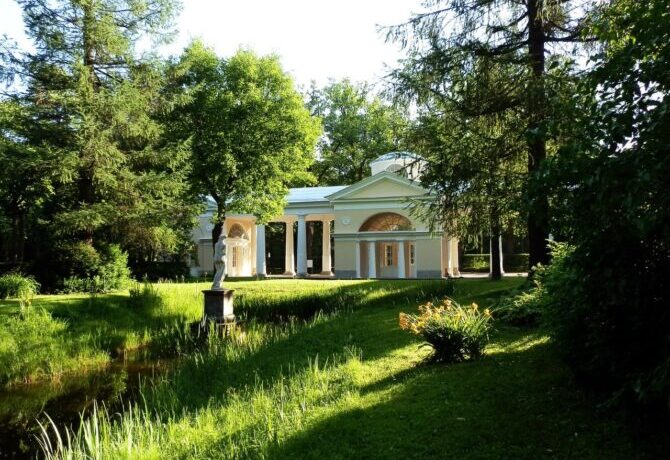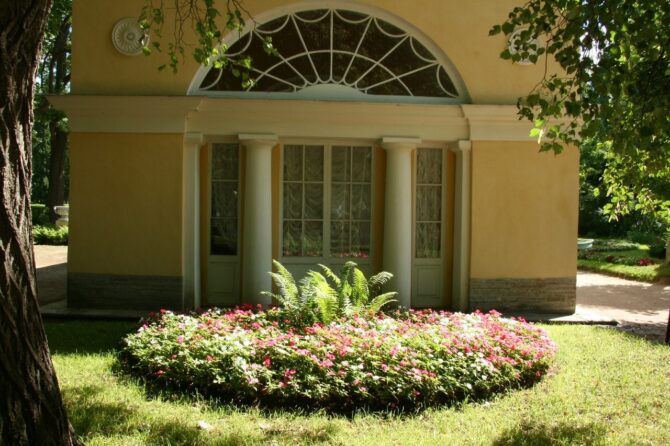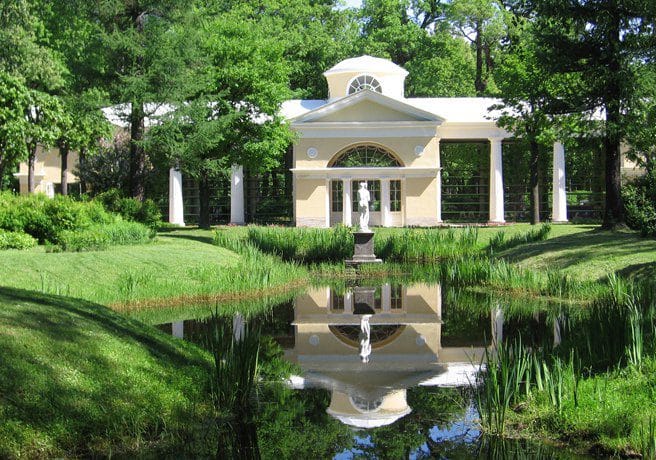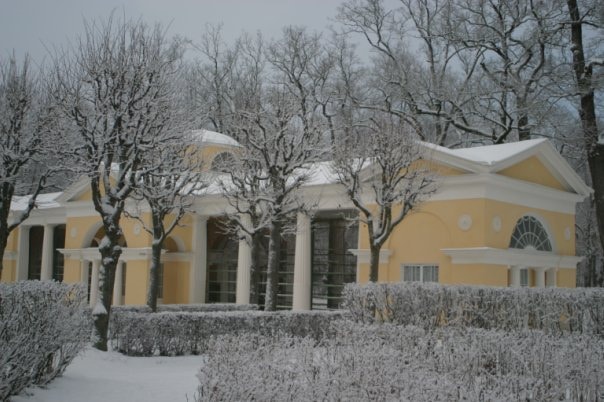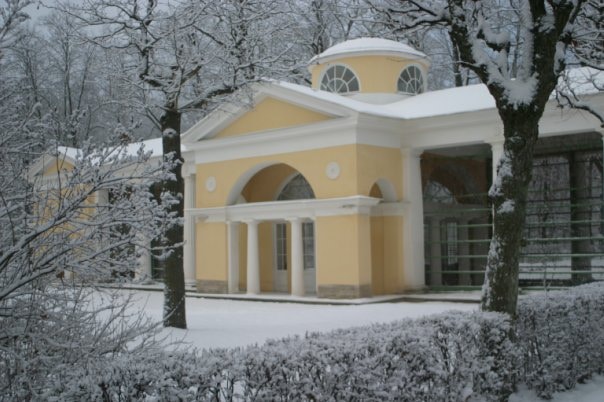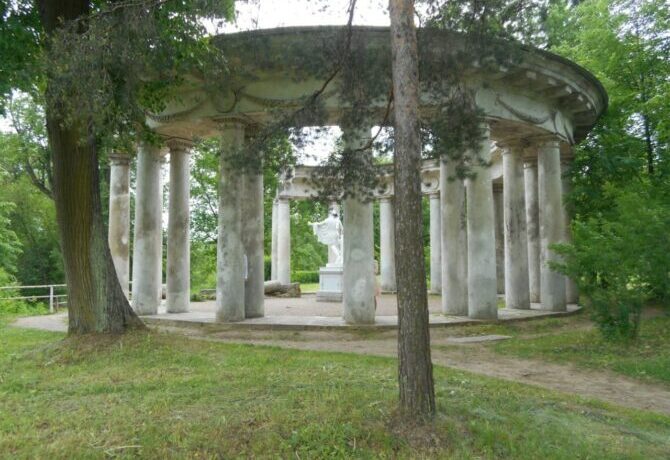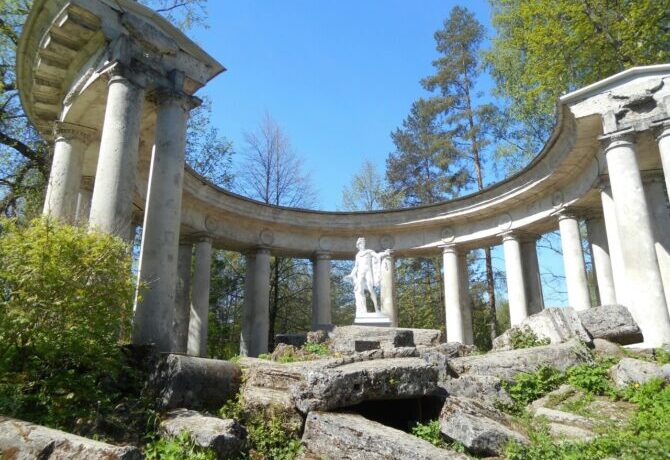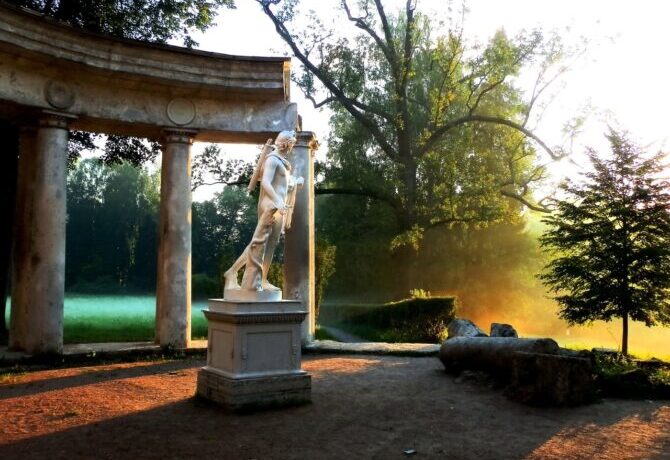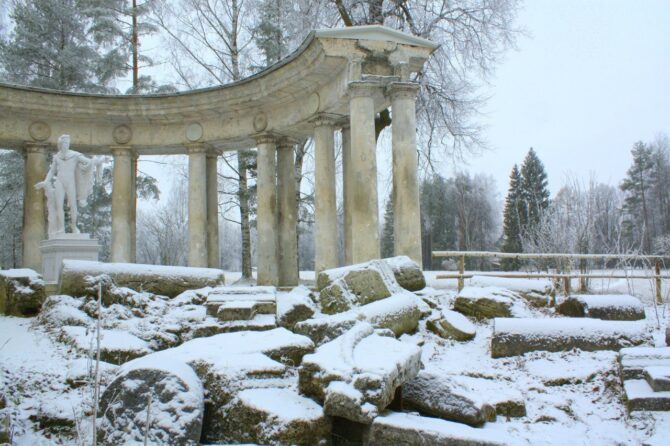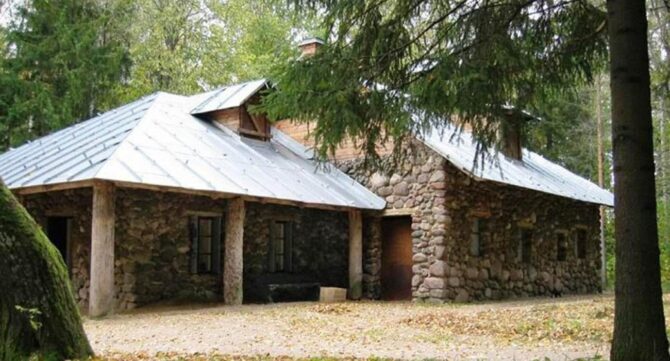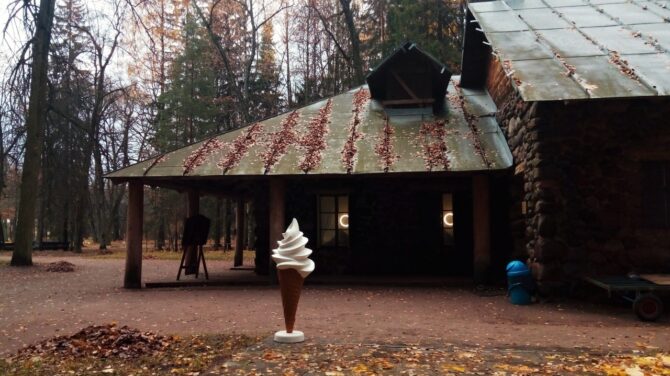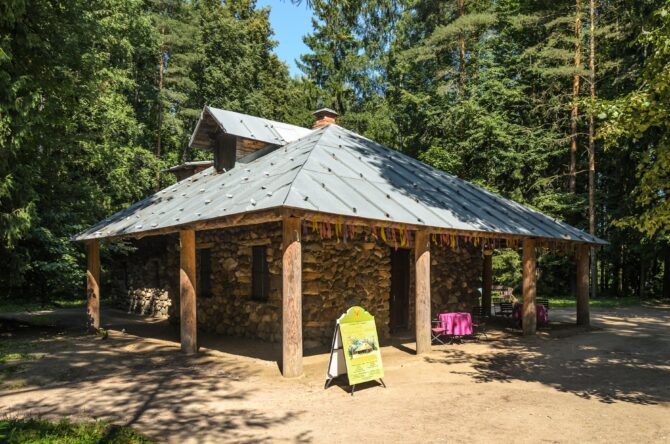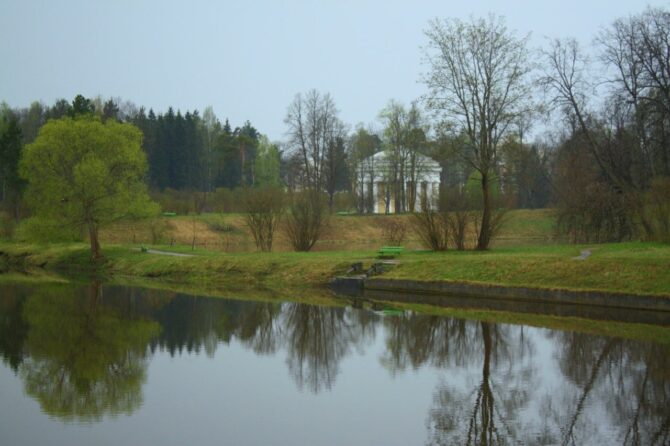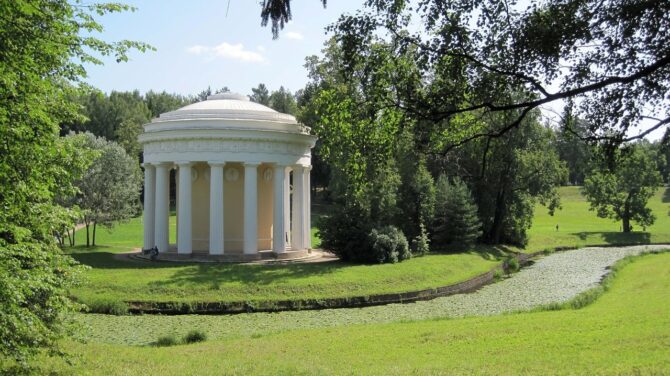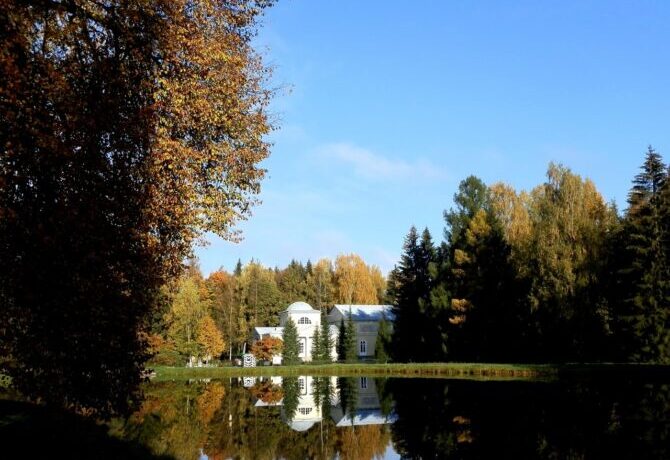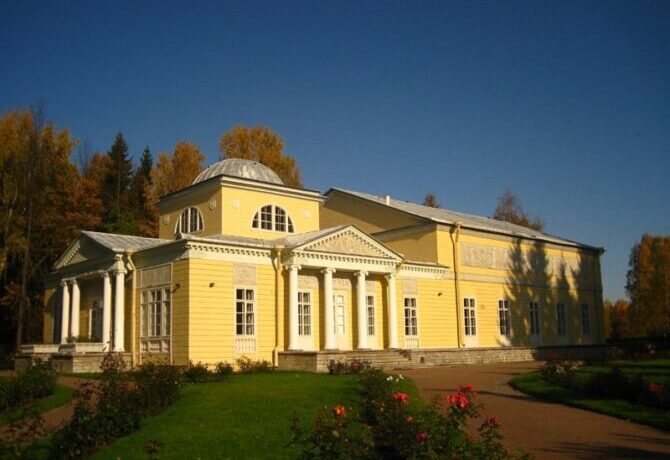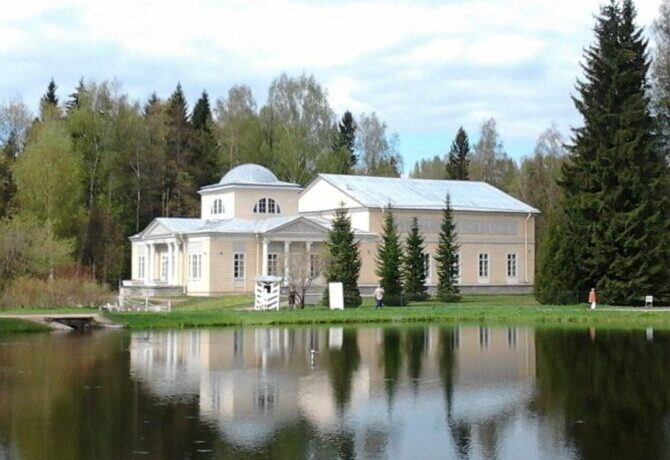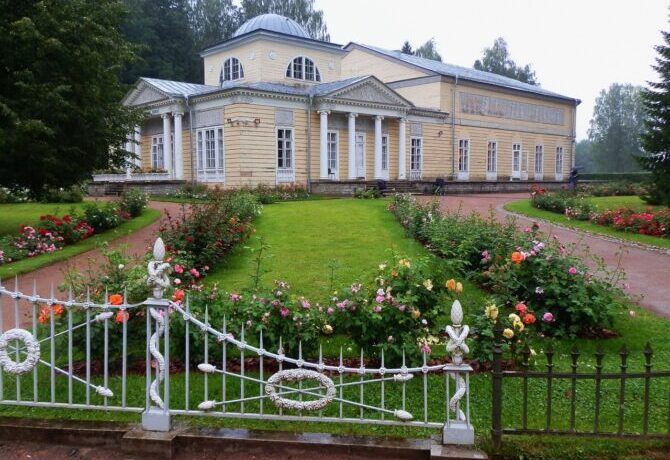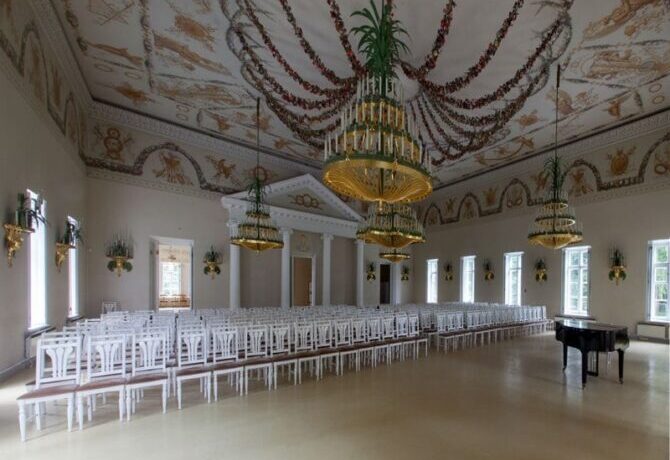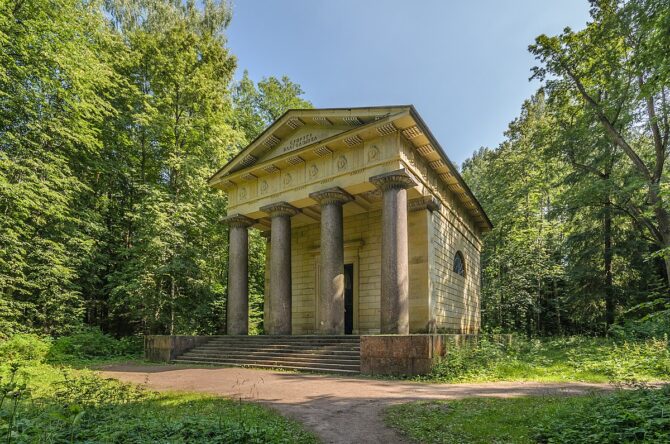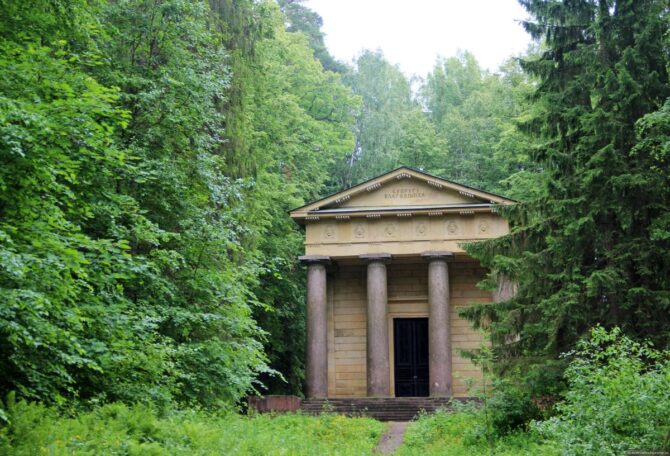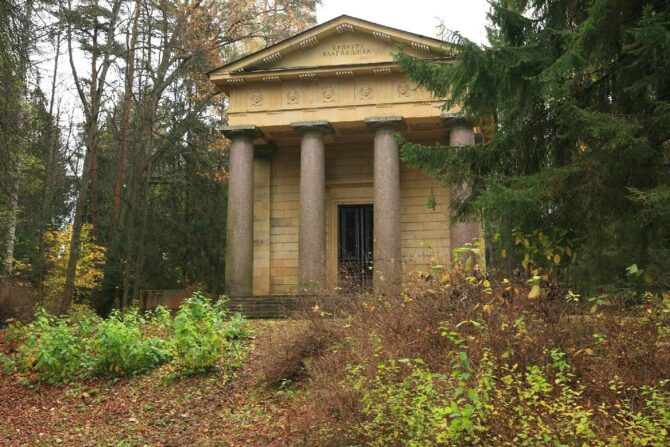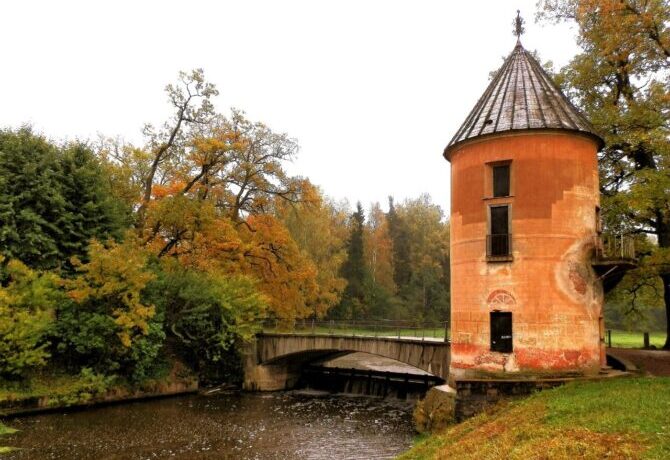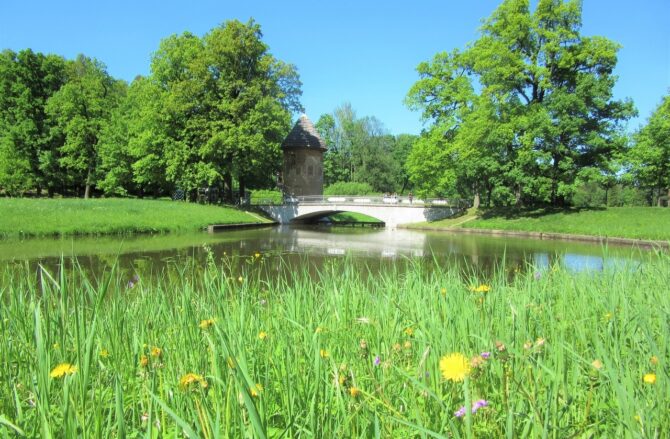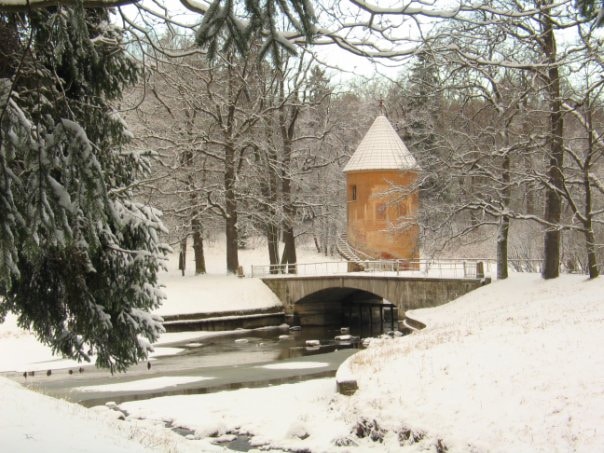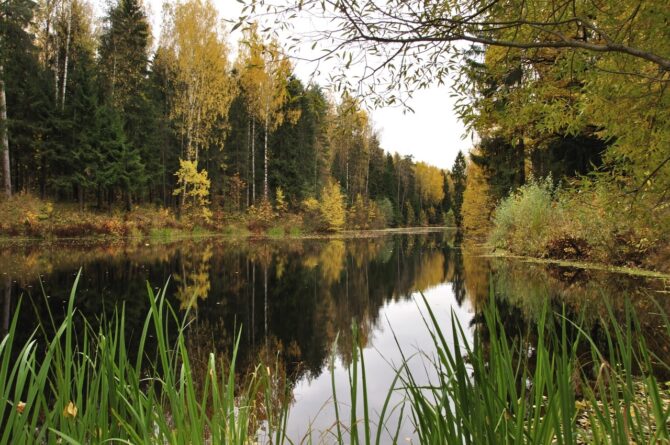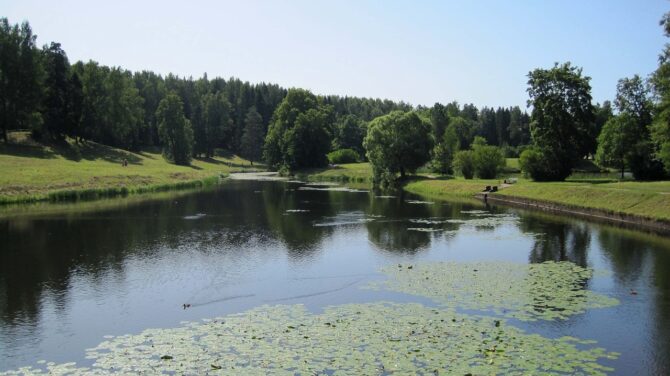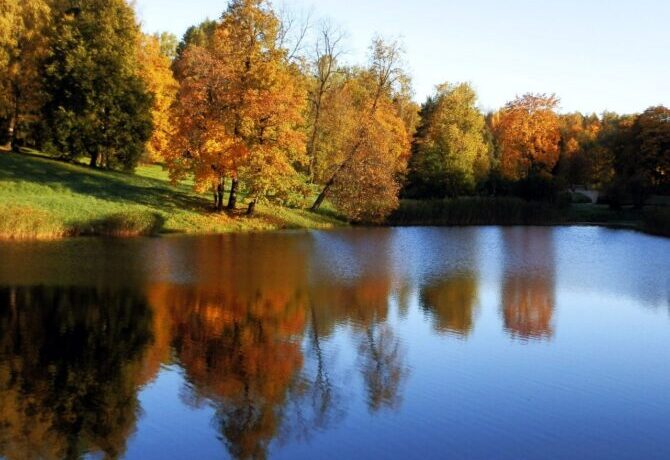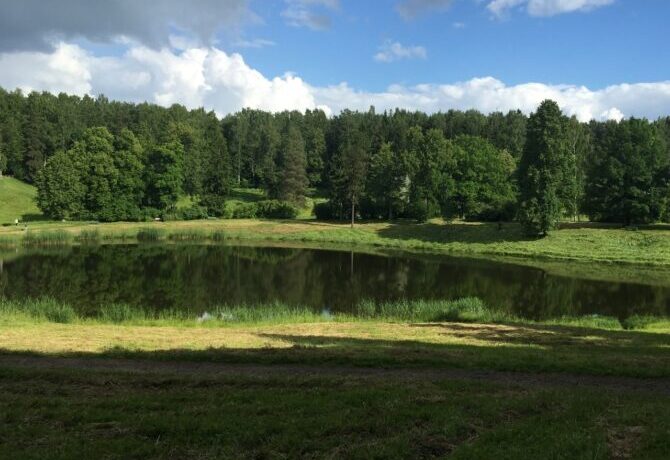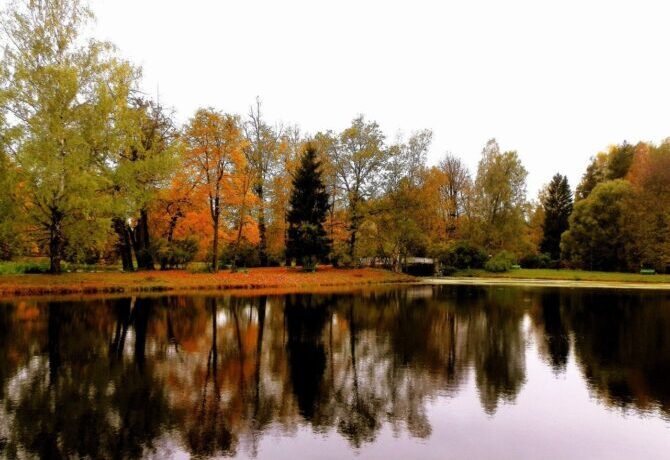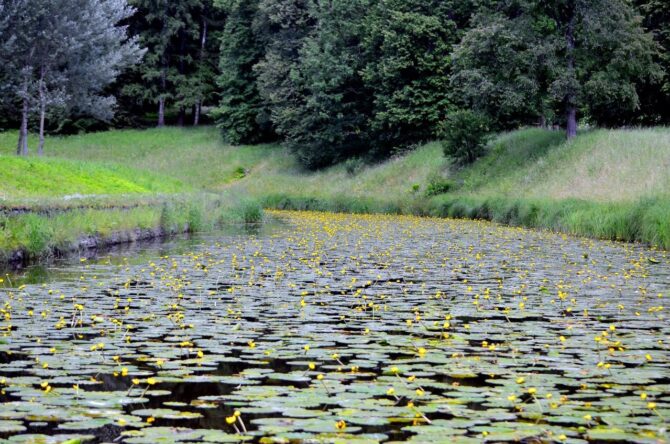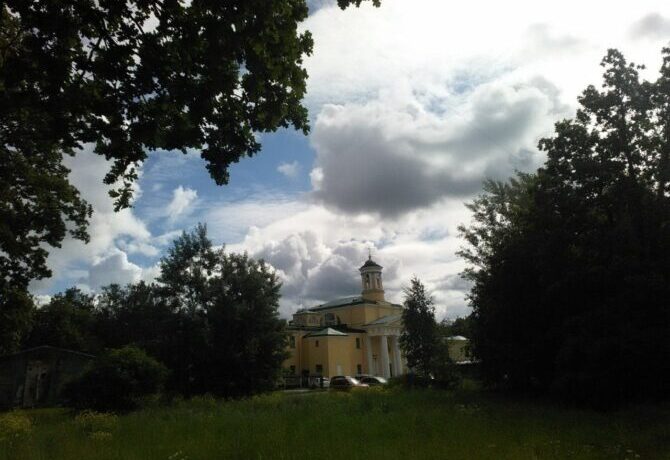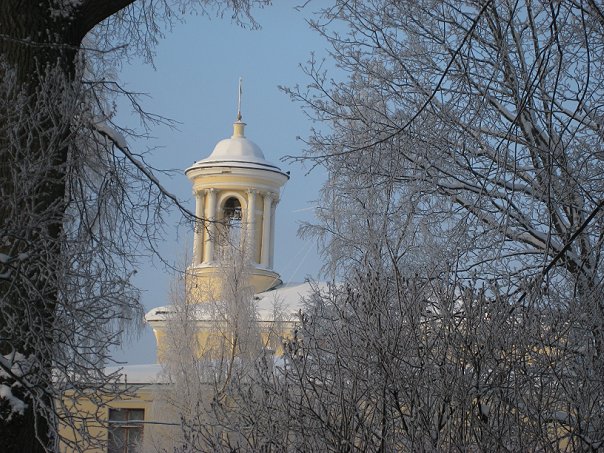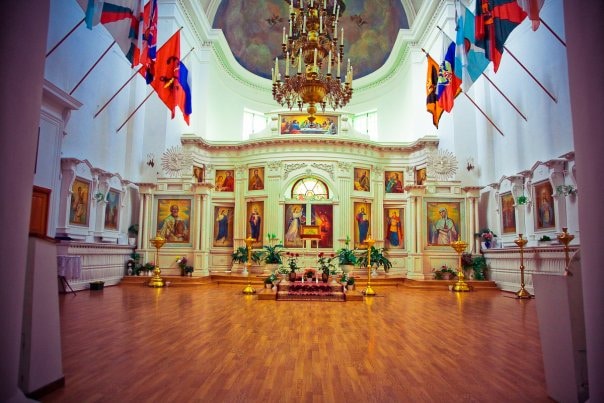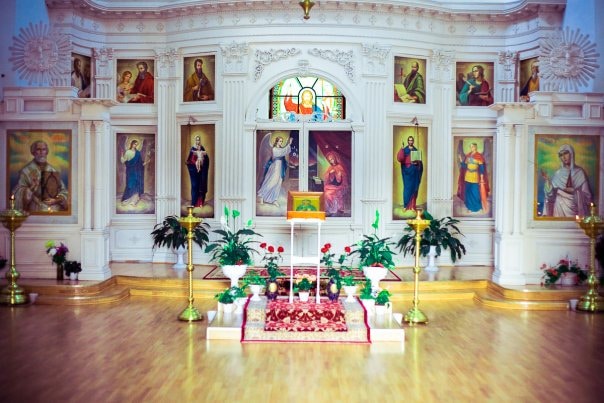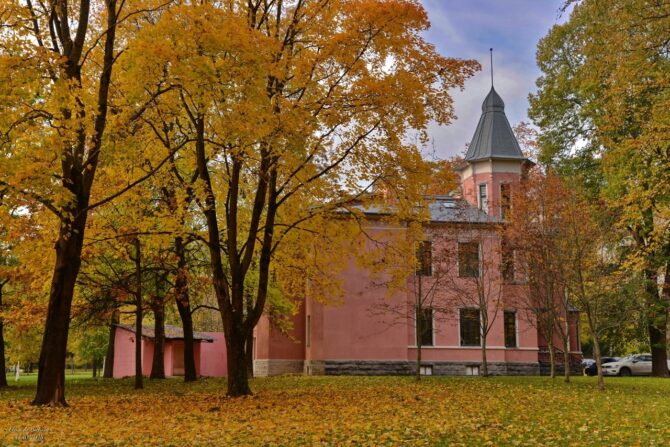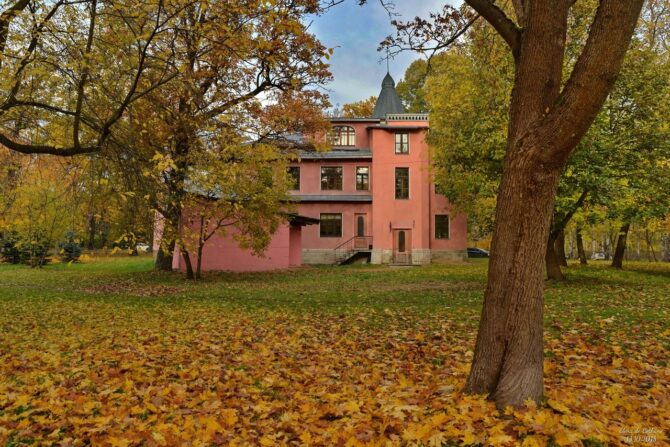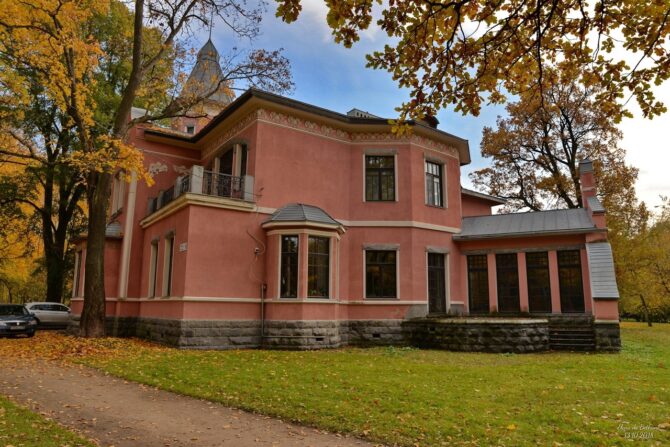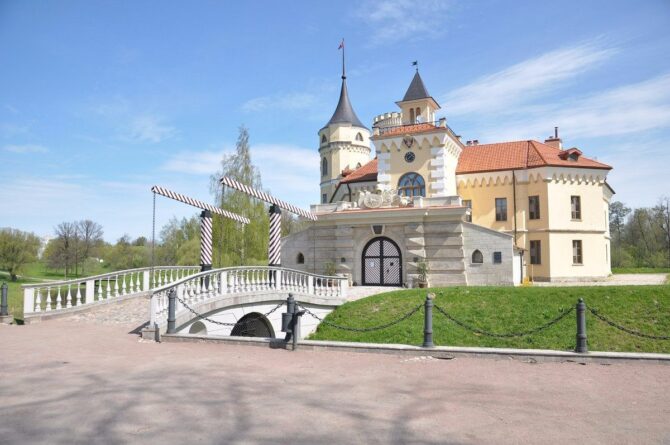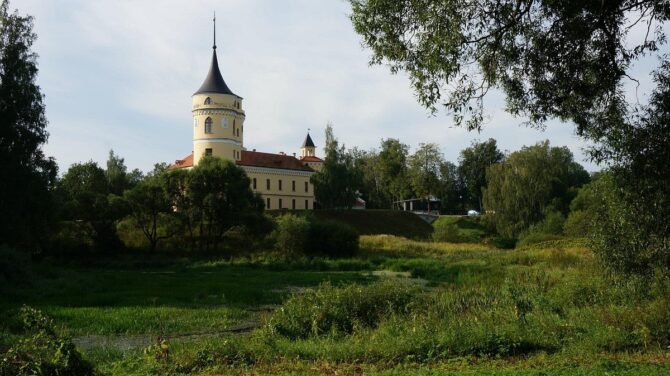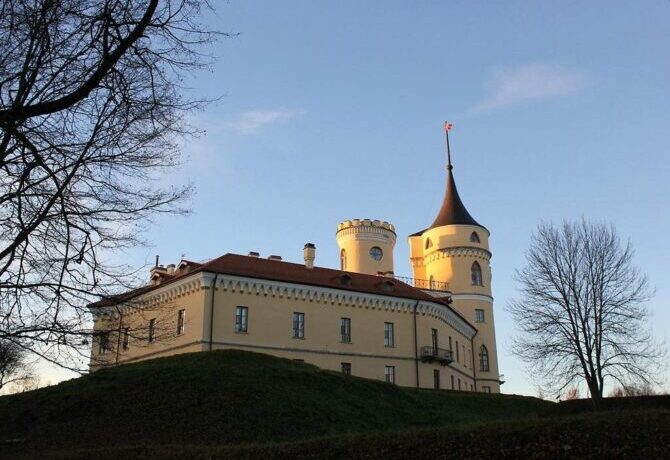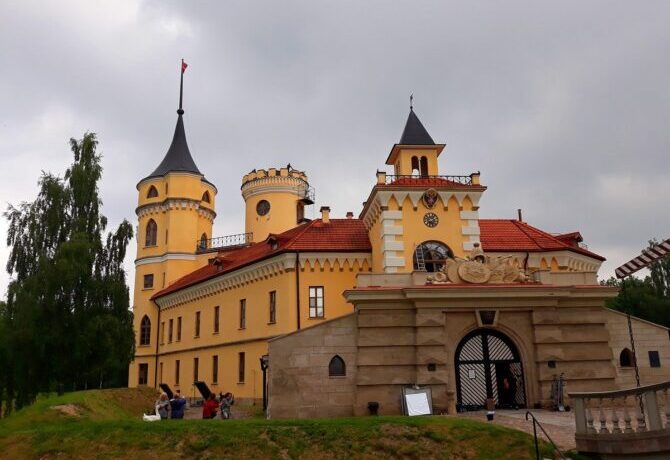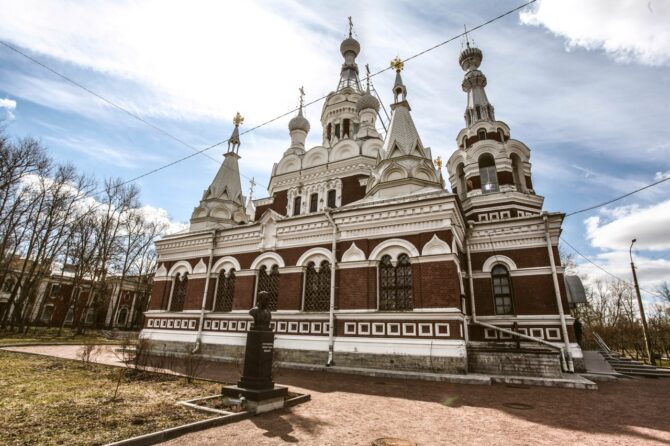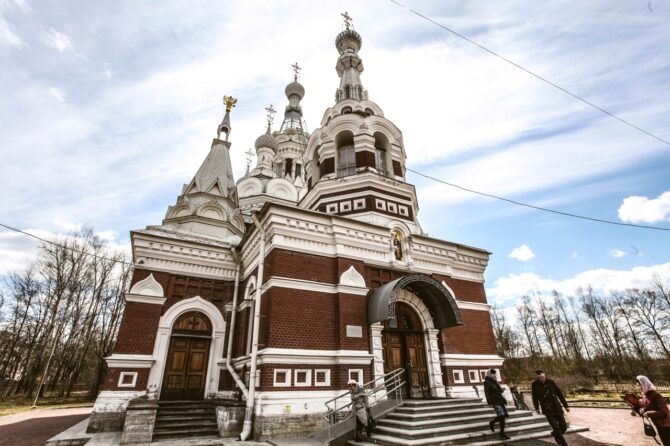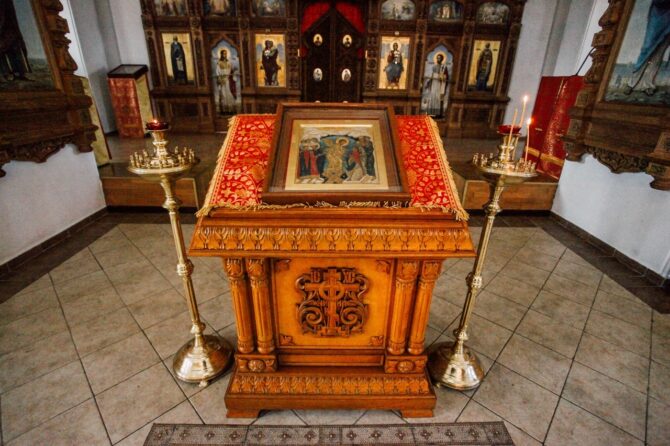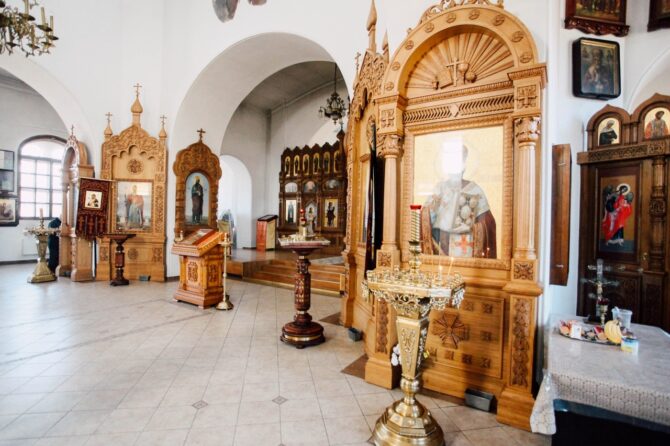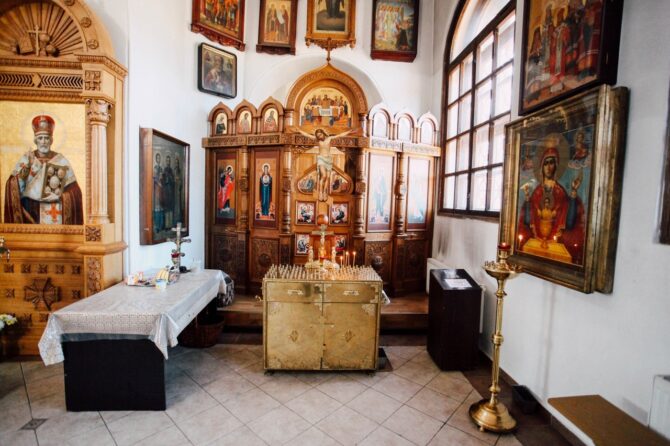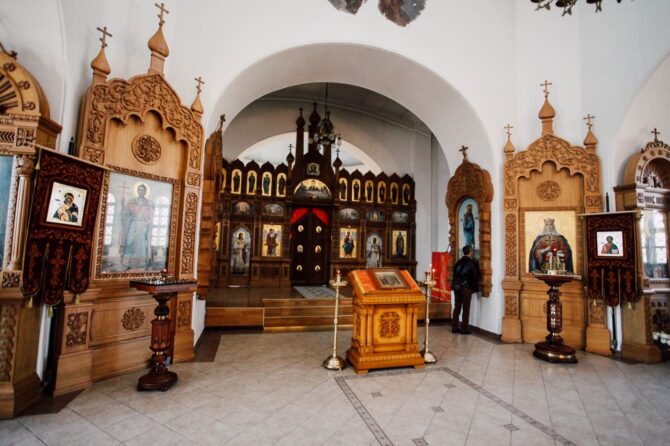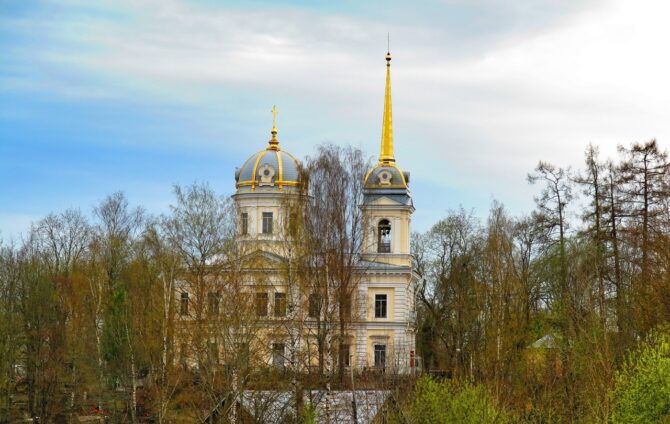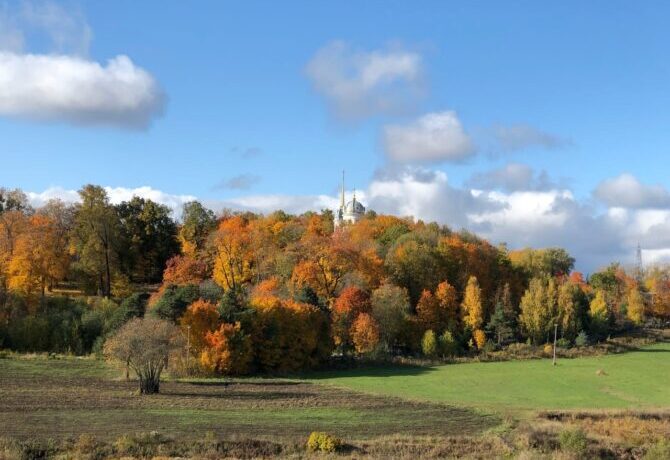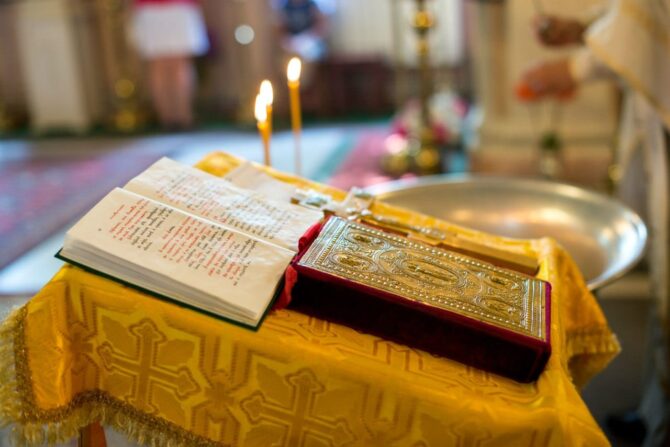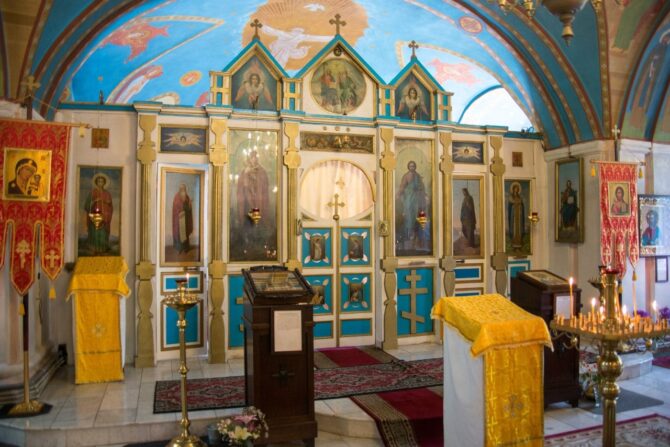Pavlovsk (Russian: Павловск) is a city in Pushkinsky District of the federal city of Saint Petersburg. The city of Pavlovsk is known for its history and remarkable architecture of the XVIII century. It is usually associated with the era of the reign of Paul I and the palace, which stood out for its beauty and was built more than 200 years ago.
- 1 Attractions Pavlovsk on map
- 2 Pavlovsk Park
- 3 Pavlovsk Palace
- 4 Pavilion “Three Graces”
- 5 Pavilion “Aviary” or Poultry House
- 6 Apollo Colonnade in Pavlovsky Park
- 7 Milk House (Milkhouse)
- 8 Temple of Friendship
- 9 Pink Pavilion or Rose Pavilion
- 10 Mausoleum of Paul I
- 11 Pil Tower
- 12 Valley of Ponds
- 13 Orthodox Church of St. Mary Magdalene
- 14 Stein’s Dacha or Miranda Villa
- 15 Bastion of Emperor Paul (BIP Fortress)
- 16 Orthodox Church of St. Nicholas the Wonderworker
- 17 Church of St. Catherine the Great Martyr and the Nativity of the Blessed Virgin Mary
Attractions Pavlovsk on map
Pavlovsk Park
Pavlovsk Park has been repeatedly praised by poets, writers, architects and ordinary travelers. Everyone who has been to this place before, dreams of coming back again. And this is easily explained: at the same time and even for a dozen visits you will not see the entire Pavlovsk Park, because it occupies an area of 600 hectares. Therefore, it is better to come here for a few days and book any nearby hotels.
Pavlovsk Park is more than 200 years old. But as it ages, surrounded by care and carefully guarded, it becomes even more charming. Only once during its existence, Pavlovsky Park looked terrible, after the Great Patriotic War. But the colossal work of restorers created a miracle: Pavlovsk Park with all its landscapes and buildings was restored.
On this truly gigantic territory grows a huge number of trees – 54 species, 16 of which were spruce, and 361 thousand plantations. Also very interesting is the situation with the fauna in Pavlovsk Park: in this place a large number of bird species – 71 species; many species of mammals, for example, you can easily notice the elk or its traces. Squirrels are very tame: they like to take treats from their hands. In winter, in Pavlovsky Park you can see a fox or even a wild boar.
Pavlovsk Park was popular both under Emperor Paul I and in Soviet times, when everything necessary for the rest of the workers was organized on the territory.
Working hours: in summer (from May 1) daily from 7:00 to 23:00, in winter (from September 1 to April 30) Pavlovsky Park is open daily from 6:00 to 21:00.
The cost of tickets to Pavlovsk Park: for adults – 100 rubles, for pensioners – 50 rubles, for children under 16 years – free of charge. Admission is paid only from 9.00 to 21.00, and from 7:00 to 9:00 and from 21:00 to 23:00 – free.
Address: Pavlovsk city, Sadovaya street, 20
The following attractions are located in Pavlovsky Park
Pavlovsk Palace
Pavlovsk Palace – the summer residence of Emperor Paul I, son of Catherine II, and his wife Maria Feodorovna – one of the most romantic palace and park complexes of the late XVIII century in the spirit of a Palladian villa. One of the builders of the complex was the Scotsman Charles Cameron, the court architect of Catherine II.
The strict square column structure of the Pavlovsk Palace is crowned with a flat illuminated dome surrounded by 64 columns. Semicircular buildings form a parade ground with a statue of Paul I in the middle. Under the dome is an Italian hall with ancient sculptures, an architectural masterpiece of classicism.
The elegantly decorated halls contain first-class works of art bought or commissioned by the owners of the Pavlovsk Palace and donated by European monarchs in 1781-1782. At that time, Paul I, while still Grand Duke Pavel Petrovich, went on a trip to Europe with his wife under the name “Count and Countess of the North”.
Pavlovsk Palace is the embodiment of the harmony of nature and art. Sentimental and romantic notes are also reflected in the design of the landscape: picturesque images of nature on the banks of the river, pastoral and classical pavilions make the Pavlovsk Palace and the park the most poetic in the world.
Address: Pavlovsk city, Sadovaya street, 20
Site: http://www.pavlovskmuseum.ru
Pavilion “Three Graces”
The pavilion of “Three Graces” is the extreme work of C. Cameron in Pavlovsk Park. The sculpture “Three Graces” became a gift to Princess Maria Feodorovna for her birthday from her son Alexander I. He purchased this composition from the Italian Augustine Triscorni and paid a fabulous amount of 11,000 rubles.
At the request of the princess, this sculpture “Three Graces” was installed in the already existing pavilion, which changed both the concept of the structure and the name of the pavilion. The ensemble of sculptures began to perfectly harmonize with the natural relief of the park and pavilion. When the war began, the sculpture “Three Graces” was buried in the ground so that it would not be found. But the Nazis still dug it up, but, fortunately, did not destroy it.
The restoration of the pavilion “Three Graces” was carried out in 1956-1957. This process took place under the guidance of the architect S. V. Popov Gunich.
Now the pavilion “Three Graces” is part of Pavlovsk Park. In this place sometimes hosts receptions and concerts of chamber music.
Address: Pavlovsk city, Pavlovsk Park territory
Pavilion “Aviary” or Poultry House
In 1782, the architect Cameron created the pavilion “Aviary” in the classical style. Geometry and strict proportions made the poultry house especially attractive. In the southern colonnade of the pavilion “Aviary” Maria Feodorovna held receptions and chamber dances.
In 1783, the pavilion “Aviary” housed antiques purchased in Italy. In 1804-1806, the architect A. N. Voronikhin built extensions to the economic buildings. Forty ancient urns and two ancient sarcophagi are located in this place.
Maria Feodorovna turned the pavilion “Aviary” into a real kingdom of the goddess Flora. In this place there were luxurious flower beds and two greenhouses in which exotic plants were grown. A marble statue of Flora was also brought from Italy and placed in the pavilion “Aviary”. On the site of greenhouses in 1862, verandas were built, between which a pond was dug.
During the Great Patriotic War, the poultry house was damaged by bomb fragments. The statues on the pond were stolen by the Nazis. In 1967-1968, a complete restoration of the fence of the pavilion “Aviary” was carried out under the guidance of architect Sofia Vladimirovna Popova-Gunich. The original appearance of the poultry house was restored.
Today, during the International Flower Festival “Imperial Bouquet”, dedicated to the memory of the first mistress of the Pavlovsk Empress Maria Feodorovna, the pavilion “Aviary” continues to become a kingdom of flora. Also in the poultry house there are exhibitions of artists, photographers, florists.
Address: Pavlovsk city, Pavlovsk Park territory
Apollo Colonnade in Pavlovsky Park
The Colonnade of Apollo is one of the masterpieces of park architecture of the late XVIII century. It was built by K. Cameron in 1782 on the left bank of the Slavyanka River.
In 1800, at the request of the Empress, the colonnade of Apollo was moved to the shore of the Slavyanka in front of the palace. According to the plan of D. Quarenghi, from the colonnade of Apollo on slavyanka, a waterfall was formed, which descended along the stone ledges to the river and violently foamed under the cantilever stone bridge before falling into it. According to ancient myth, the colonnade of Apollo was supposed to represent Mount Parnassus, where Apollo and the Muses lived, and the waterfall, the key of Castal, was a source of inspiration.
However, in 1817, during a severe storm, the base of the Apollo colonnade over the waterfall was demolished, and several columns and part of the entablast collapsed. The collapsed details of the colonnade of Apollo decided not to touch, as nature itself created the appearance of picturesque ruins, which gave this landscape a romantic character.
Address: Pavlovsk city, Sadovaya street, Pavlovsky Park
Milk House (Milkhouse)
By order of Maria Feodorovna in 1782 near the palace, behind the Great Circles, the architect Charles Cameron built Charbonnière (“miner’s apartment”), the so-called Milk House (milk house). It is a thatched-roof farmhouse built of large boulders.
First, this milk empress was to be built by Cameron on the model of the “Milk House” in the estate of the Duke of Württemberg. The Grand Duchess changed the milk and sent the architect a drawing of the desired building. The milk house is like an alpine house with a canopy for a bell. The thatched roof is firmly constructed and supported by wooden supports. The exterior walls are lined with stone.
Some dairy rooms were functional: they were used to keep cows and store milk. In the south-western extension of the dairy house there was a luxurious living room with silk walls, beautiful furniture, porcelain vases and expensive plates on marble shelves. There is a legend that Maria Feodorovna herself milked cows and treated the courtiers with black bread and milk.
In 1786, the cows were brought to a small stable nearby, and the dairy house was turned into a park gazebo for quiet walks. Repeated fires and wars destroyed all the wooden parts and interior decoration of the milk. The appearance of milk was restored in Soviet times. The dairy house was lined with galvanized iron, the interior was restored.
Address: Pavlovsk city, Pavlovsky Park, 12
Temple of Friendship
This masterpiece of classical park architecture was built by Charles Cameron in 1782. The Temple of Friendship is located on the peninsula formed by the Slavyanka River, and is an integral part of the landscape, creating a harmony of architecture and nature.
The Temple of Friendship is one of Cameron’s first designs, which he designed shortly after arriving in Russia. The laying of the Temple of Friendship took place in the summer of 1780 in the presence of Emperor Joseph II. The construction work lasted about two years. During the trip abroad, Maria Feodorovna was very interested in the progress of work in correspondence with Küchelbecker.
The Church of Friendship was dedicated to Catherine II. Above the doors was an inscription in gilded bronze letters: “Love, reverence and gratitude dedicated.” The inscription, which disappeared after the revolution, was restored during the restoration of the Church of Friendship in 2008. Inside the pavilion, in front of the entrance, there is a statue of Catherine II in the image of Ceres.
Outside, on the cell of the Temple of Friendship, in the cracks between the columns there are bas-relief medallions made by Rashet. They repeat four allegorical scenes dedicated to Catherine II: the personification of generosity, Minerva-Victoria, the presentation of the act of donation on the possession of Pavlovsk lands and the symbol of justice.
The Temple of Friendship was intended for the organization of dinners and small concerts. To organize dinner in the neighboring pavilion on the banks of the Slavyanka built a ruin kitchen, which has not survived to this day.
Working hours: daily from 11:00 to 18:00, except Monday and Tuesday
Cost: free of charge upon presentation of the entrance ticket to the park
Address: Pavlovsk city, Sadovaya street, 20
Pink Pavilion or Rose Pavilion
The pink pavilion is located in the most picturesque place of Pavlovsk Park on the border of 3 districts: Old Sylvia, White Birch and Parade Field. The pink pavilion is a wooden building with 4 facades and a small dome. It was built in 1807-1812 by the architect A. N. Voronikhin.
The pink pavilion was surrounded on all sides by roses, which were also the main theme of its interior decoration. In 1814, in honor of the return of Alexander I from Paris after the victory over Napoleon, a ballroom designed by C. Rossi and P. Gonzago was appointed to the Rose Pavilion in 17 days. The double-lit ballroom with an area of about 400 square meters amazes with the splendor of the decoration.
Italian decorator and architect Pietro di Gottardo Gonzago (Peter Fedorovich Gonzaga) not only participated in the construction of the ballroom with Rossi, but also drew for the ball theatrical scenery on shields depicting a Russian country village. These landscapes, created in the open air, against the background of the landscapes of Pavlovsky Park immersed all those present in a rural corner with supposedly real buildings. In this place were depicted people solemnly meeting the Russian army, which won the war.
Address: Pavlovsk city, Pavlovsk Park territory
Mausoleum of Paul I
The original name of this attraction is the church of Paul I or the monument to Paul I. It was built according to the project of J. Thome de Thomon and is the architectural dominant of the Pava Park.
To preserve the memory of her unforgettable husband, the widowed Empress Maria Feodorovna decided to erect an architectural monument to him – the mausoleum of Paul I. A competition was announced for the best project, the winner was Toma de Thomon, a native of France. The construction of the mausoleum of Paul I was carried out from 1806 to 1810. The building was built in the form of an ancient Roman temple.
The majestic sandstone building stands on a granite pedestal with wide steps, a four-columned portico holds a tympanum with the inscription: “Spouse to the benefactor”, and on the opposite side – the words: “To Paul I emperor and Autocrat of All-Russia. Born September 20th day, 1754. To the deceased march of the 11th day of 1801.” On the frieze of the mausoleum of Paul I are depicted weeping masks.
Around the mausoleum of Paul I were planted tall yels, which once again emphasized the funerary character of the building. The central facade of the mausoleum of Paul I, located above the gorge, is clearly visible from the central road, but you can get to it only along a narrow path that passes through a cast-iron tombstone.
Address: Pavlovsk city, Pavlovsk Park territory
Pil Tower
This is a two-story high pavilion of Pavlovsk Park, designed as an original architectural work in the pastoral-romantic style. At the turn of the XVIII and XIX centuries, when planning and building a saw tower, it was fashionable to design outwardly modest buildings with the appearance of poverty and decorate them with royal luxury from the inside.
Outside, the saw tower is painted with patterns imitating the brickwork at the bottom and the wooden cladding on top, and the roof is covered with ordinary straw. An additional external staircase of the saw tower leads to the second floor: the Romanovs preferred to enter the room through the balcony to bypass the utility rooms.
The saw tower was designed by Pietro Gonzago with the help of Vincenzo Brenna, architect Schröter and bricklayer Visconti. According to one version, the name of the saw tower comes from the sawmill that stood in its place, according to another – from the English Peel Tower: the so-called watchtowers in The UK in the XV century.
The first floor of the pil tower served as a chamber for servants in the time of Paul I, the second was used by the owners themselves: it was exquisite and incredibly expensive, decorated with stucco and paintings by famous artists. Unfortunately, part of the decoration of the saw tower is lost, but after the restoration of the second floor, the interior decoration of the late 18th – early XIX centuries was recreated.
On the second floor of the saw tower are now temporary exhibitions, but only in the summer, as the pavilion is not heated.
Address: Pavlovsk city, Pavlovsk Park territory
Valley of Ponds
The Valley of Ponds is one of the most picturesque areas of Pavlovsky Park, which originally belonged to the Big Star district, but still the place received its own unique appearance in the 1890s according to the project of the Italian master Pietro Gonzago. The architect created a chain of artificial reservoirs, taking into account the features of the relief and harmoniously combining artificial and natural elements.
Today, the valley of the ponds is bounded from the southwest by Sadovaya Street and separated from the northwest from the Big Star by a chain of ponds. The landscapes of the “Valley of Ponds” are mostly vast meadows, fringed by narrow strips of trees and planted with ornamental shrubs.
There are many bright places in this place – the reconstructed pavilion of the Old Chalet with a small forest, the wall of the Grand Cascade and one of the most romantic places – the Gate with fruit pots, symbolizing eternal love.
Address: Pavlovsk city, Sadovaya street, Pavlovsky Park
Outside of Pavlovsky Park, too, a lot of interesting places
Orthodox Church of St. Mary Magdalene
Catherine II gave Grand Duke Pavel Petrovich land on the banks of the Slavyanka River and allowed her son to equip the city of Pavlovsk at his discretion. And the first stone building in the new city of Pavlovsk was the Orthodox Church, consecrated in the name of Mary Magdalene.
In May 1781, in the presence of Tsarevich Paul, the first stone was laid in the foundation of the future church of St. Mary Magdalene. The author of the project is the famous Italian architect Giacomo Quarenghi. The painting of the inner walls was made by the Russian artist Fyodor Danilov. Icons for the new church of St. Mary Magdalene were commissioned by the Italian master Cades. The construction work of the church lasted three years, and in September 1784 Metropolitan Gabriel consecrated the new church.
In 1797, the Empress opened a shelter at the Church of St. Mary Magdalene. At various times, up to 20 widows, the disabled and the homeless lived in this place at the same time. In 1809, a hospital was built, where doctors treated poor residents and beggars, and a pharmacy, where medicines were distributed free of charge.
After the revolution, the inhabitants of the city of Pavlovsk could not save the church of St. Mary Magdalene. It was closed in 1931, the sanctuaries desecrated and looted. Instead of a hospital, a shoe factory was placed. During the Nazi occupation, the Church of St. Mary Magdalene housed repair shops. In 1956, a metal toy factory moved to the church. The constant vibration of the equipment and the use of aggressive technical fluids in the production at times caused irreparable damage to the Church of St. Mary Magdalene.
Only in 1960 the state took the Church of St. Mary Magdalene under its protection. In 1995, the Church of St. Mary Magdalene was recognized as an architectural monument. The church was in a dilapidated state, so services after the consecration were not held. St. Mary Magdalene’s Church did not work until 1999. Restoration work began in 1998 and lasted several years. At the same time, on the vaults of the Church of St. Mary Magdalene, paintings of the early XIX century were discovered and restored.
Address: Pavlovsk city, Sadovaya street, 17
Stein’s Dacha or Miranda Villa
This original mansion in the Art Nouveau style inevitably attracts the attention of tourists to the city of Pavlovsk. The tower on the roof, the exquisite stucco of the façade, the protruding bay windows – all these are design elements of the dacha of Ilya Borisovich Stein, known since the 1920s as a villa with the romantic name Miranda.
The two-storey stone building was built in 1908 by architect Alexander Vasilyevich Kenel for the merchant of the second guild V. I. Kostinsky, and 8 years later sold to the entrepreneur.
After the revolutions of 1917, the building, surrounded by a steel fence on a stone base, was used in different ways. The authorities even wanted to organize a night casino with a rich and exquisite interior in this place by 1922 and invite Leonid Utesov himself to sing there. At the end of the Great Patriotic War, a post office with a traditional telegraph was opened in this place.
Since 2011, a child development center has been operating at Steinn’s dacha, founded by the family of conductor Maxim Dmitrievich Shostakovich, the son of a famous Russian composer, pianist and teacher.
Address: Sadovaya street, 9
Bastion of Emperor Paul (BIP Fortress)
The bastion of Emperor Paul was built in 1797 by order of Emperor Paul I. Like many buildings in Pavlovsk Park, it was destroyed during the war, it was razed to the ground in 1944. And only in 2011, thanks to the holding company “Gutsait Group”, this place was restored and now it is included in the hotels of the city of Pavlovsk.
The hotel recreates the spirit and atmosphere of the imperial residence to the smallest detail. The 22 rooms, including those of Paul I, are decorated with red brick and antique furniture. By the way, you can feel like an emperor if you remove the whole castle.
In addition to the castle, the ramparts and ravelins surrounding the bastion were restored, as well as one of the drawbridges. They are still trying to restore the surrounding space. For example, in the newly created garden on the eastern slope, in the castle itself, as well as in the Pavlovsk menagerie, various herbs and vegetables are grown, and to the delight of young guests, hotels breed various birds and animals.
At the same time, the historical and gastronomic attraction of the castle is the “Field Kitchen of Pavel Petrovich”. This is a local restaurant, for which, according to ancient drawings, a copper oven was built. It is suitable for cooking such delicacies as “Big Hot Meat Still Life”, in it you can cook a whole bull.
This place is also included in the most unusual hotels in St. Petersburg.
Address: Pavlovsk city, Mariinskaya street, 4
Orthodox Church of St. Nicholas the Wonderworker
The Church of St. Nicholas the Wonderworker was built in 1900-1904 by the architect A. I. von Gauguin, in memory of Emperor Paul I. The Orthodox Church of St. Nicholas the Wonderworker was built on the site of a wooden church built in 1841 for soldiers of an exemplary cavalry regiment.
The church of St. Nicholas the Wonderworker was consecrated on August 28, 1902. And in 1926, the temple was closed by the Soviet authorities. Until 1991, the Church of St. Nicholas the Wonderworker housed a tank workshop and a warehouse of a military unit. After returning to the faithful on June 29, 1991, it was consecrated for the second time, at the same time the church of St. Nicholas the Wonderworker was given the status of a cathedral.
Today, at the Church of St. Nicholas the Wonderworker, there is a workshop for sewing gold, in which experienced masters create unique liturgical vestments and objects of church life.
Address: Pavlovsk city, Artillery street, 2
Reference: http://www.pavlovsk-xram.ru
The next attraction is not in the city of Pavlovsk. To visit it, you need to lay down more time for the trip or book hotels nearby
Church of St. Catherine the Great Martyr and the Nativity of the Blessed Virgin Mary
This is a restored architectural monument of the first half of the XVIII century. The place where the church of the Holy Great Martyr is located used to be called the tsar’s slavyanka or Count’s Slavyanka.
Initially, this two-story church of the Holy Great Martyr was built in the style of King Louis XIV. However, it was rebuilt in the first half of the XIX century by architect C. Adamini by order of the famous Countess Julia Samoilova. And after almost half a century, through the efforts of A. I. Pezanov, the church returned to its original appearance.
The lower church of the Holy Great Martyr was dedicated to the Virgin, and the upper one to the Madonna. Images for iconostasis carved from wood were made according to the sketches of A. P. Bryulov. Later, they were covered with gold and silver robes thanks to generous donations.
The Church of the Holy Great Martyr was not closed until 1938. And in 1938 its abbot was arrested and the church of the Holy Great Martyr was closed. From that moment on, the church had a cinema and a small club. The main dome and church tower were blown up in 1941 to remove a landmark for German artillery. During the occupation, believers first gathered in a separate building, and in 1943 services were held in the church of the Holy Great Martyr.
After the seizure of the church of the Holy Great Martyr for several years, she did not accept believers, but repair work began here, and then in 1946 regular divine services began.
Address: Pavlovsk city, Dynamo village, Parkovaya street, 1
Pavlovsk is a beautiful, green and picturesque city that can be visited at any time of the year and in any weather. Despite its compact size, the city of Pavlovsk has many attractions that deserve the attention of tourists. To see all the important places, you should come here for at least three days.

